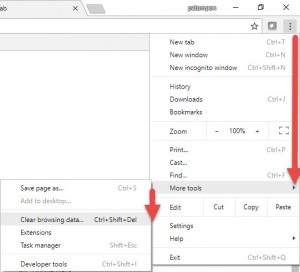

There we have it – two different methods for
 Click Passwords and other sign-in data and Auto-fill form data. Scroll down again and click Clear browsing history. Click the three stacked dots in the top right. This may beĭifferent for each device, and it will depend on if you signed in and usedĪutofill on that device prior to signing in to your Google account.Įither way, clearing your cache can be done If, after deleting your passwords, they stillĪppear during sign in, you may need to clear your cache too. Click to turn off Offer to save passwords and Auto sign-in. You will then be given options to turn off password saving. Before you leave, you should click the Settings cog in the top right. The steps to clear your cache may vary slightly from the steps detailed below.On this page, you can now delete any saved passwords. Make sure there’s a check-mark next to Cookies, site data and Cached images and files. Tap History and then Clear browsing data. At the bottom right, tap the three gray dots. In the Chrome app On your iPhone or iPad, open the Chrome app.
Click Passwords and other sign-in data and Auto-fill form data. Scroll down again and click Clear browsing history. Click the three stacked dots in the top right. This may beĭifferent for each device, and it will depend on if you signed in and usedĪutofill on that device prior to signing in to your Google account.Įither way, clearing your cache can be done If, after deleting your passwords, they stillĪppear during sign in, you may need to clear your cache too. Click to turn off Offer to save passwords and Auto sign-in. You will then be given options to turn off password saving. Before you leave, you should click the Settings cog in the top right. The steps to clear your cache may vary slightly from the steps detailed below.On this page, you can now delete any saved passwords. Make sure there’s a check-mark next to Cookies, site data and Cached images and files. Tap History and then Clear browsing data. At the bottom right, tap the three gray dots. In the Chrome app On your iPhone or iPad, open the Chrome app.  Make sure that Browsing history, Cookies and other site data and Cached images and files are all selected. Select the desired Time range from the drop down (recommend All Time). Click the three gray dots in the top right of the menu that appears. From the Safari menu, click Clear History. Make sure Cached images and files and Cookies and other site data are selected. From the drop-down menu click Clear browsing data. Click the three gray dots in the upper right hand corner of the window. To clear cache, locate the browser you are using in the list below and follow the instructions. Note: Cached credentials, including passwords and Two Step authentication, will be cleared when following the instructions below. enhances system and application performance. helps web applications run better on your computer. Clearing the cache in your web browser can fix basic web page issues, including if web pages are not loading correctly or displaying errors.
Make sure that Browsing history, Cookies and other site data and Cached images and files are all selected. Select the desired Time range from the drop down (recommend All Time). Click the three gray dots in the top right of the menu that appears. From the Safari menu, click Clear History. Make sure Cached images and files and Cookies and other site data are selected. From the drop-down menu click Clear browsing data. Click the three gray dots in the upper right hand corner of the window. To clear cache, locate the browser you are using in the list below and follow the instructions. Note: Cached credentials, including passwords and Two Step authentication, will be cleared when following the instructions below. enhances system and application performance. helps web applications run better on your computer. Clearing the cache in your web browser can fix basic web page issues, including if web pages are not loading correctly or displaying errors.










